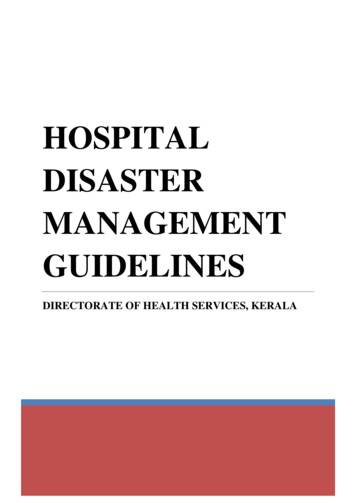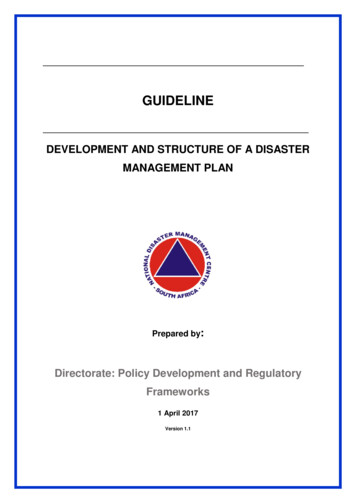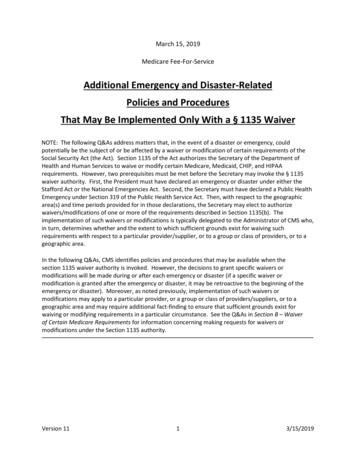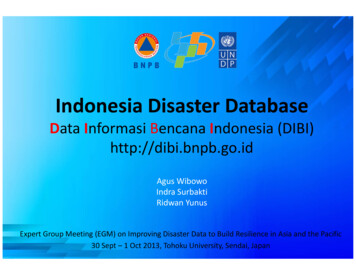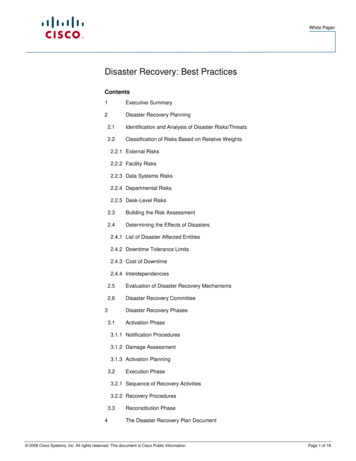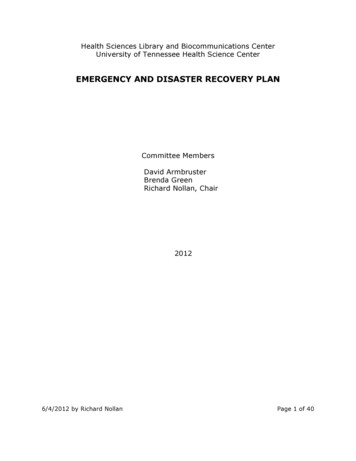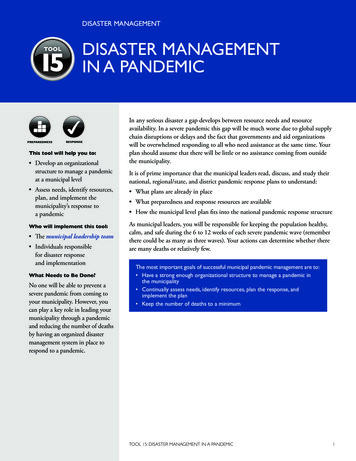
Transcription
DISASTER MANAGEMENTTOOL15PREPAREDNESSDISASTER MANAGEMENTIN A PANDEMICRESPONSEThis tool will help you to: Develop an organizationalstructure to manage a pandemicat a municipal level Assess needs, identify resources,plan, and implement themunicipality’s response toa pandemicWho will implement this tool: The municipal leadership team Individuals responsiblefor disaster responseand implementationWhat Needs to Be Done?No one will be able to prevent asevere pandemic from coming toyour municipality. However, youcan play a key role in leading yourmunicipality through a pandemicand reducing the number of deathsby having an organized disastermanagement system in place torespond to a pandemic.In any serious disaster a gap develops between resource needs and resourceavailability. In a severe pandemic this gap will be much worse due to global supplychain disruptions or delays and the fact that governments and aid organizationswill be overwhelmed responding to all who need assistance at the same time. Yourplan should assume that there will be little or no assistance coming from outsidethe municipality.It is of prime importance that the municipal leaders read, discuss, and study theirnational, regional/state, and district pandemic response plans to understand: What plans are already in place What preparedness and response resources are available How the municipal level plan fits into the national pandemic response structureAs municipal leaders, you will be responsible for keeping the population healthy,calm, and safe during the 6 to 12 weeks of each severe pandemic wave (rememberthere could be as many as three waves). Your actions can determine whether thereare many deaths or relatively few.The most important goals of successful municipal pandemic management are to: Have a strong enough organizational structure to manage a pandemic inthe municipality Continually assess needs, identify resources, plan the response, andimplement the plan Keep the number of deaths to a minimumTOOL 15: DISASTER MANAGEMENT IN A PANDEMIC1
STEPS TO FOLLOW FOR AN EFFECTIVEPANDEMIC RESPONSEINTRODUCTIONIt is strongly recommended that your municipal leadership team work within existingdisaster preparedness and response structures in the municipality. There is no reasonto change a disaster management system that works! In fact, existing plans andresources are the foundation on which to build a local pandemic plan.Therefore, prior to launching a pandemic preparedness and response effort in amunicipality, the first step should be to read and follow the directions of the national,regional/state, or district pandemic response plan.Finally, during any gathering before or during a pandemic, flu prevention protocolsshould always be exercised in order to protect against infection. Participants should beadvised to: Wash their hands frequently Cover coughs and sneezes Keep their distance Consider masks, if available Inform the group by phone or messenger and stay at home if feeling illSTEPS:How to Create an Emergency Operations Center (EOC)1. Before a severe pandemic arrives in the municipality, convene a meeting of allmunicipal leaders to include elected and appointed officials and private-sector leaders.2. During this meeting select the most interested, qualified, and competent personsto lead each of the sectors listed in the table. In addition to the sector lead,identify at least one additional person per sector to provide relief and backup forthe main representative. (See Tool 16: Maintenance of Essential Services)3. Establish an independent physical location for the EOC where these people canwork near one another and easily share information. If possible, the EOC shouldbe located near the office of the mayor or other designated municipal leader.4. To begin pandemic preparedness and response work in the municipality,complete the following EOC assignments. Please note that these assignments aremeant to be completed over several days:Initial EOC Assignments: Complete the set-up of the EOC physical space. This space will need tobe large enough to house all EOC members at the same time. Each EOCmember will need a chair and desk (or table space), access to a workingcommunication device* (cellular phone, landline phone, handheld radio,other), and a paper sign with the name of the sector clearly written and postedfor other EOC members to see. Copies of all existing plans and contactinformation for all EOC members should also be provided (See Handout 1).1. Establish an emergency operations center Develop a municipal resource list and resource map (See Step 2).2. Continually assess needs, identify resources, and plan for response Plan and implement your municipal response (See Step 3).3. Implement the response Include a plan for police or other security officers to protec.t all criticalresources and facilities, if needed.4. Prepare for community recovery Support response team activities.STEP 1: ESTABLISH AN EMERGENCY OPERATIONS CENTERThe Emergency Operations Center (EOC) is a vital component of an effectivedisaster response center. The mayor and support staff responsible for the regular, dailyfunctioning of the municipality may need to strengthen the organizational structureto manage a severe pandemic. Working with leaders from both the public and privatesectors, create an EOC if one is not already present.* Individual communication devices are a critical resource for effective pandemicmanagement. If possible, all municipal leaders should have individualcommunication devices and a master list of contact numbers (or access channelsin the case of radio). These numbers should be written down and distributed.An EOC will: Work from a shared physical location Identify pandemic response sector representatives (see suggested sectors in the tableon page 4) Include many already identified municipal leaders and disaster response personnel Serve as the center of all pandemic planning and response Keep the mayor updated and informed regarding the status of the pandemic, thestatus of all pandemic response activities, and the status of all available resources Support the needs of all responders2LEADERSHIP DURING A PANDEMIC: WHAT YOUR MUNICIPALITY CAN DOTOOL 15: DISASTER MANAGEMENT IN A PANDEMIC3
THE EMERGENCY OPERATIONS CENTERSectorPandemic Management FunctionMayor or local leader Executive leadershipTelecommunications andinformation technology Oversight of communications within the disastermanagement response structure Coordination with telecommunications andinformation technology providers Maintenance and repair of telecommunications andinformation technology Public safety and security Community-wide health promotion, infectionprevention, and household preparedness Medical care for pandemic and non-pandemic disease Emergency food/food aid Mental health servicesPublic health andmedical services Public works4PoliceFirePublic safety and security supportSupport to access, traffic, and crowd controlFacility and resource securityCoordination of first responder and emergencymedical activitiesUtilitiesWaterRoadsGarbage removal and sanitationInfrastructure protection and emergency repairEngineering services and construction managementCommunications andexternal affairs Emergency public information and protectiveaction guidance Media and community relations Trained media spokespersons Intergovernmental communicationsLogistics and transportation Logistics planning Resource support (facility space, office equipmentand supplies, contracting services, etc.) Maintenance and repair of transportation Vehicles Mass fatality planningFood security Food safety and security Food stockpile assistanceMunicipal finance Trade and commerce LaborLEADERSHIP DURING A PANDEMIC: WHAT YOUR MUNICIPALITY CAN DOSectorPandemic Management FunctionBusiness sector Volunteer coordinator Maintain up-to-date information on potentialvolunteers for all sectors Coordinate training and use of volunteersCommunity recovery Social and economic community impact assessment Short-term relief activities Long-term recovery and resilience buildingBankingCommercial enterprisesChamber of CommerceSmall businessesOther (as needed)STEP 2: CONTINUALLY ASSESS NEEDS, IDENTIFYRESOURCES, AND PLAN FOR RESPONSERemember to read and follow the directions of the national, regional/state, or districtpandemic response plan, as these plans will serve as the basis upon which to build amunicipal response.You and your disaster response team will need to focus on accomplishing thefollowing goals simultaneously. The primary goal will be to keep the number ofdeaths in a municipality to a minimum, so first consideration should be given to whatpeople need to stay alive during a severe pandemic.HOW TO ASSESS AND IDENTIFY MUNICIPAL RESOURCESDevelop a resource list.Each EOC representative should identify and list any and all resources that mightbe required to meet the needs of their sector. For example, the EOC representativefor transportation should ask vehicle owners in the municipality if their vehiclescould be made available for pandemic response activities. From these responses, thetransportation representative then compiles a master list of all available vehicles. Inaddition, a handout is provided to begin to assess healthcare resources as an example.Similar documents should be developed for the other sectors.As each EOC representative develops a similar list, the EOC will have a strongindication of which resources are available for pandemic response. Over time,resource availability will change; this is important information for the municipalleaders to have in making decisions.One of the most important resources that will be needed for the response is humanresources. Volunteers will be needed to assist in a variety of tasks, both ones thatrequire special skills and others that do not require skills or expertise. In a severepandemic, there will be a role for anyone who is available to assist.TOOL 15: DISASTER MANAGEMENT IN A PANDEMIC5
A volunteer coordinator should be designated to compile a master list of allvolunteers, trained and untrained, and to coordinate the use of the volunteers duringthe response. (For more information, see Tool 17, Volunteer Coordination and Tool16, Maintenance of Essential Services.) Work assignments:Develop a municipal resource map.STEP 3: IMPLEMENT THE RESPONSETypically a map of the municipality will be available in the mayor’s (or designatedmunicipal leader’s) office or can be obtained from a local office of law enforcement,firefighters, emergency medical services, or the military. In the event a municipal mapis unavailable, the EOC should draw a simple municipal map as shown in the pictureat left. Such maps typically include useful information such as key landmarks, roads,water, schools, places of worship, and other infrastructure. The EOC should identifylisted resources on its municipal map using colored stick pins or labels.The above municipal response plan, along with a resource list and map, will serve as thebasis for implementing the day-to-day pandemic response. This response will be ledby the EOC and carried out in regular work shifts.The municipal resource map will help determine what gaps in resources exist inthe municipality, while demonstrating to the community at large that an organizedpreparedness and response effort is underway. Update of all major response activities carried out by sector during the last shiftIdentify gaps and plan to address them.Once both the needs for resources and the available resources have been identified,you can begin to develop priority areas to address existing gaps. An example may bethe need to determine how to prioritize anticipated needs for gasoline or electricity inthe event there is an insufficient amount available.Develop a multisector municipal response plan.As discussed, the national, regional/state, and district pandemic response will serveas the basis upon which to build the municipal response plan. Be sure to include thelocal reinforcement of all national messages in your plan.-- Determine what needs to get done to achieve the above objectives.-- Delegate assignments to appropriate EOC sector representatives.Hold a daily or work-shift update meeting: Each work shift should begin with abriefing of EOC representatives coming on duty by those finishing a shift. Topics tobe covered in this meeting include: Update of the latest pandemic information and any public communication Update of all major non-response occurrences during last shift Update of the resource list and resource map to show what’s still available whereWrite up a (1- to 2-page) daily response plan: Immediately following the shiftupdate meeting, EOC representatives coming on duty should write up a dailyresponse plan to include: Period of time to be covered by the plan Objectives to be achieved during the coming shift Delegation of work detailing which EOC sector representatives are responsible forwhich specific tasks to achieve the objectives of the day Expected weather forecast as this can greatly impact mobility of resources andtransport of personnelA municipal response plan should include the following: Reminder of personal protective measures (social distancing, personal hygiene) Overall goal of the plan: Keep the number of deaths in the municipality toa minimum.STEP 4: PREPARE FOR COMMUNITY RECOVERY Key objectives of the plan (use the Tools to develop these):-- Provide executive leadership, including continuing essential government andprivate sector services during the pandemic, and determining who will holdauthority in the municipality, in the event the mayor (or designated municipalleader) becomes ill or dies. (For more information, see Tool 16, Maintenance ofEssential Services.)-- Limit the spread of disease in the municipality. Establish policies for social distancing (See Tool 5, Non-PharmaceuticalInterventions (NPIs): Actions to Limit the Spread of the Pandemic inYour Municipality). Determine legal framework for social distancing policies-- Assure adequate food and water for everyone in the municipality (See Tools7–11 in the Food Security and Livelihoods section).This municipal pandemic management tool is cyclical in nature. Once the municipalleaders have finalized the organizational structure, assessed needs, identified resources,and developed a municipal plan, the daily update meetings and response implementationshould be repeated for as long as resources and capable personnel are needed.Strong municipal pandemic management is one of the most important steps towardthe future recovery of a community following a pandemic. However, there arenumerous other activities municipal leaders can undertake to enhance and acceleratethe municipality’s recovery following a pandemic. These activities include those thatreduce fear (of going without food, of getting the flu, of death, of crime and violence)and that restore confidence (in government, in fellow citizens, and in the ability tomake a living). (For more information, see Tool 19, Recovery and Resilience.)Leaders must continually ask the question, “What can we do to help our communityrecover from the pandemic?”-- Use available healthcare resources to reduce deaths from both pandemic andnon-pandemic illness (See Tools 3, 4, 5, and 6 in the Health section).-- Maintain calm (See Tools 12, 13, and 14 in the Crisis and Emergency RiskCommunications section).6LEADERSHIP DURING A PANDEMIC: WHAT YOUR MUNICIPALITY CAN DOTOOL 15: DISASTER MANAGEMENT IN A PANDEMIC7
HANDOUT 1EMERGENCY RESPONSE TEAM CONTACT LISTOnce your municipality’s official emergency response team has been assembled, fill out and keep handy a contact list for all teammembers, such as in the example below. (Please note this list is not in order of importance.)Date last updatedTeam MemberMayor (or municipal leader)Emergency Response ChairpersonPublic Safety and SecuritySector Coordinator(includes police, fire, emergencymedical services)Public Health and MedicalServices Sector CoordinatorPublic Works Sector Coordinator(includes water, power,sanitation, road repair)8LEADERSHIP DURING A PANDEMIC: WHAT YOUR MUNICIPALITY CAN me:Cell:Cell:Email:Email:TOOL 8: CLASSIFICATION OF FOOD SECURITY RISK LOCATIONS—USER GUIDE (HANDOUT)9
HANDOUT 1Team MemberCommunications and ExternalAffairs SectorLead Coordinator(Includes trained media spokesperson)Logistics and TransportationCoordinatorFood Sector Coordinator(food security)Business Sector Liaison(trade, commerce, banking,tourism, labor)Volunteer CoordinatorRecovery Coordinator10PrimaryBackupName:Name:Work:Team MemberMunicipal Finance Sector mail:Email:Cell:Cell:Email:Email:LEADERSHIP DURING A PANDEMIC: WHAT YOUR MUNICIPALITY CAN DOTelecommunications and IT ServicesOthers as available and needed, such as: Social services Family welfare Faith/religion counselor School coordinator Community liaison Legal representative NGO representativesTOOL 15: DISASTER MANAGEMENT IN A PANDEMIC (HANDOUT)11
HANDOUT 2ASSESSING HEALTHCARE RESOURCESMunicipality: Village/Neighborhood: Date:Describe Resources AvailableTotal # of inpatient beds(in hospitals, privateclinics, health posts)Services available athealthcare facilities (forexample: ventilators,intensive care,respiratory isolation,intravenous hydrationand antibiotics,laboratory, maternal andchild care, surgery)Maximum # ofoutpatient clinic andoffice visitsper dayDoctorsNursesPharmacistsCommunity healthworkersCommunity volunteersTraditional healers12LEADERSHIP DURING A PANDEMIC: WHAT YOUR MUNICIPALITY CAN DOTOOL 8: CLASSIFICATION OF FOOD SECURITY RISK LOCATIONS—USER GUIDE (HANDOUT)13
14LEADERSHIP DURING A PANDEMIC: WHAT YOUR MUNICIPALITY CAN DO
The most important goals of successful municipal pandemic management are to: Have a strong enough organizational structure to manage a pandemic in the municipality Continually assess needs, identify resources, plan the response, and implement the plan Keep the number of deaths to a minimum TOOL 15: DISASTER MANAGEMENT IN A PANDEMIC
